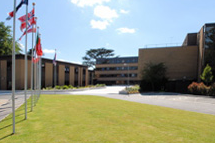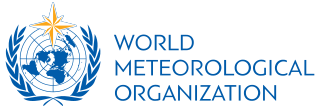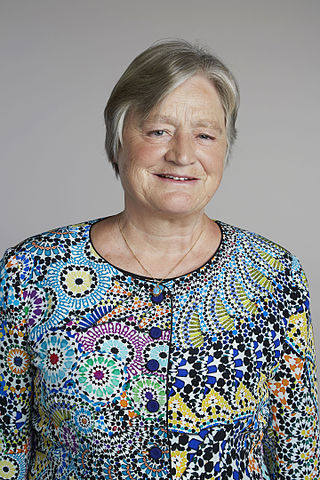Related Research Articles

The European Centre for Medium-Range Weather Forecasts (ECMWF) is an independent intergovernmental organisation supported by most of the nations of Europe. It is based at three sites: Shinfield Park, Reading, United Kingdom; Bologna, Italy; and Bonn, Germany. It operates one of the largest supercomputer complexes in Europe and the world's largest archive of numerical weather prediction data.

The World Meteorological Organization (WMO) is a specialized agency of the United Nations responsible for promoting international cooperation on atmospheric science, climatology, hydrology and geophysics.

The Meteorological Office, abbreviated as the Met Office, is the United Kingdom's national weather service. It is an executive agency and trading fund of the Department for Science, Innovation and Technology and is led by CEO Penelope Endersby, who took on the role as Chief Executive in December 2018 and is the first woman to do so. The Met Office makes meteorological predictions across all timescales from weather forecasts to climate change.

The European Organisation for the Exploitation of Meteorological Satellites (EUMETSAT) is an intergovernmental organisation created through an international convention agreed by a current total of 30 European Member States.

The Meteosat series of satellites are geostationary meteorological satellites operated by EUMETSAT under the Meteosat Transition Programme (MTP) and the Meteosat Second Generation (MSG) program.
The Global Earth Observation System of Systems (GEOSS) was built by the Group on Earth Observations (GEO) on the basis of a 10-Year Implementation Plan running from 2005 to 2015. GEOSS seeks to connect the producers of environmental data and decision-support tools with the end users of these products, with the aim of enhancing the relevance of Earth observations to global issues. GEOSS aims to produce a global public infrastructure that generates comprehensive, near-real-time environmental data, information and analyses for a wide range of users. The Secretariat Director of Geoss is Barbara Ryan.
Météo-France is the French national meteorological service.

In atmospheric science, an atmospheric model is a mathematical model constructed around the full set of primitive, dynamical equations which govern atmospheric motions. It can supplement these equations with parameterizations for turbulent diffusion, radiation, moist processes, heat exchange, soil, vegetation, surface water, the kinematic effects of terrain, and convection. Most atmospheric models are numerical, i.e. they discretize equations of motion. They can predict microscale phenomena such as tornadoes and boundary layer eddies, sub-microscale turbulent flow over buildings, as well as synoptic and global flows. The horizontal domain of a model is either global, covering the entire Earth, or regional (limited-area), covering only part of the Earth. The different types of models run are thermotropic, barotropic, hydrostatic, and nonhydrostatic. Some of the model types make assumptions about the atmosphere which lengthens the time steps used and increases computational speed.

The Norwegian Meteorological Institute, also known internationally as MET Norway, is Norway's national meteorological institute. It provides weather forecasts for civilian and military uses and conducts research in meteorology, oceanography and climatology. It is headquartered in Oslo and has offices and stations in other cities and places. It has around 500 full-time staff and was founded in 1866.
Aksel C. Wiin-Nielsen was a Danish professor of meteorology at University of Copenhagen, University of Michigan, Director of the European Centre for Medium-Range Weather Forecasts (ECMWF), and Secretary-General of the World Meteorological Organization (WMO).
The State Meteorological Agency is a state agency of the Government of Spain responsible for providing weather forecast, warnings of hazardous weather and assisting the administrations in such matters. The AEMET is part of the Secretariat of State for Environment of the Ministry for the Ecological Transition and is headquartered in the University City, Madrid. The agency was known as Central Institute of Meteorology from 1887 to 1978 and National Institute of Meteorology from 1978 to 2008 when it adopted its current name.

The Croatian Meteorological and Hydrological Service is a public entity for meteorology, hydrology and air quality in Croatia.

Timothy Noel Palmer CBE FRS is a mathematical physicist by training. He has spent most of his career working on the dynamics and predictability of weather and climate. Among various research achievements, he pioneered the development of probabilistic ensemble forecasting techniques for weather and climate prediction. These techniques are now standard in operational weather and climate prediction around the world, and are central for reliable decision making for many commercial and humanitarian applications.

Julia Mary Slingo is a British meteorologist and climate scientist. She was Chief Scientist at the Met Office from 2009 until 2016. She is also a visiting professor in the Department of Meteorology at the University of Reading, where she held, prior to appointment to the Met Office, the positions of Director of Climate Research in the Natural Environment Research Council (NERC) National Centre for Atmospheric Science and founding director of the Walker Institute for Climate System Research.
Laxman Singh Rathore is an Indian scientist, former Director General of India Meteorological Department, New Delhi. and permanent representative of India with World Meteorological Organization, United Nations.
THORPEX is an international research programme established in 2003 by the World Meteorological Organization (WMO) to accelerate improvements in the utility and accuracy of weather forecasts up to two weeks ahead. It is part of the World Weather Research Programme and is a key component of the WMO Natural Disaster Reduction and Mitigation Programme.
The THORPEX Interactive Grand Global Ensemble (TIGGE) is an implementation of ensemble forecasting for global weather forecasting and is part of THORPEX, an international research programme established in 2003 by the World Meteorological Organization to accelerate improvements in the utility and accuracy of weather forecasts up to two weeks ahead.
The International Meteorological Organization Prize is awarded annually by the World Meteorological Organization (WMO) for outstanding contributions in the field of meteorology and, since 1971, the field of operational hydrology.

Jukka Petteri Taalas is a Finnish meteorologist and Secretary-general of the World Meteorological Organization. Appointed in 2015 by the World Meteorological Congress, the supreme body of the Organization, he took up the four-year Secretary-General term on 1 January 2016, and was re-elected to a second four-year term on 13 June 2019. He was director general of the Finnish Meteorological Institute from 2002 to 2005 and 2007 to 2015.
References
- ↑ Walter Leal Filho; Evangelos Manolas; Anabela Marisa Azul; Ulisses M. Azeiteiro; Henry McGhie (2017). Handbook of Climate Change Communication: Vol. 1. Springer. pp. 312–. ISBN 978-3-319-69838-0.
- ↑ Ghassem R. Asrar; James W. Hurrell (2013). Climate Science for Serving Society: Research, Modeling and Prediction Priorities. Springer Science & Business Media. pp. 475–. ISBN 9789400766921.
- ↑ "African Centre of Meteorological Application for Dev - Organization Contacts - Professional Resources". PreventionWeb.net. Archived from the original on July 25, 2009.
- ↑ "AUC, ACMAD, AGRHYMET, ASECNA". www.eumetsat.int. Archived from the original on July 7, 2011.
- ↑ "African Centre of Meteorological Applications for Development (ACMAD)". TrustAfrica. Archived from the original on 2013-04-16.
- ↑ "ECMWF Overview". European Centre for Medium-Range Weather Forecasts. Archived from the original on April 20, 2012.